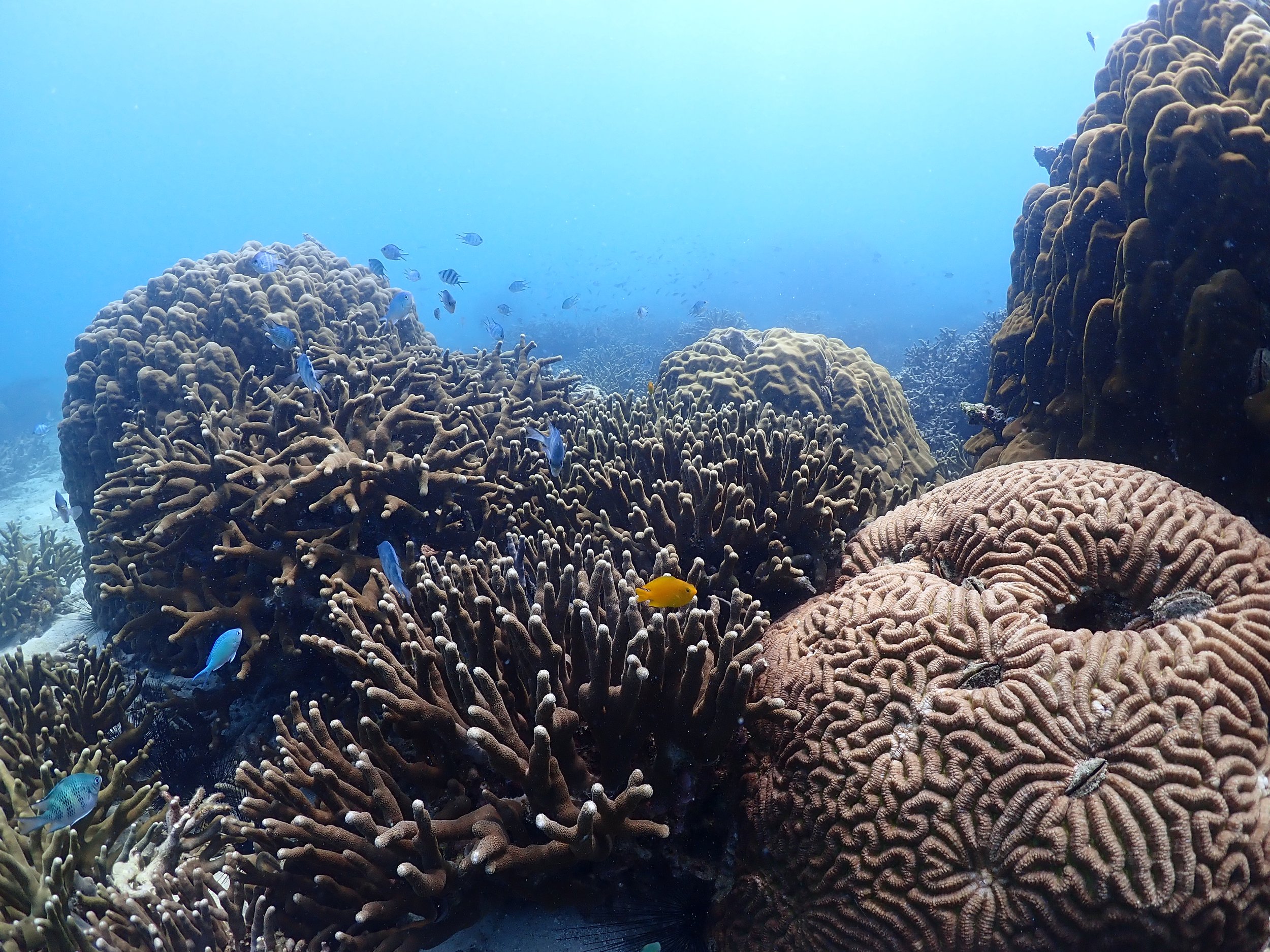Resilience? Again?
Yes, those of you who have read my posts before will notice that I have talked about resilience before (here and here). So why am I speaking about it again?
Because I believe that ensuring our reefs – and other marine ecosystems – are resilient is critical to protecting their long-term health and productivity.
And our recently released annual survey report suggests that we are not paying sufficient attention to looking after these important marine resources.
It becomes imperative as signs are showing that there will be a significant mass coral bleaching event sooner than you think.
What is Coral reef resilience?
A brief recap. Ecological resilience refers to the ability of an ecosystem (such as a coral reef) to maintain key functions and processes in the face of external stresses or pressures, by resisting or adapting to change.
Glad we got that sorted out! Put more simply – it determines whether an ecosystem can either shrug off or recover from, an external stressor…or whether the ecosystem declines.
Status of Coral Reef in Malaysia
Reef Check Malaysia’s early survey data for Malaysia demonstrate the resilience of coral reefs. The graph below shows the change in a key reef health indicator, Live Coral Cover (LCC), since we started collecting data.
The status of reef health in Malaysia from 2007 - 2023.
What is coral bleaching?
In 2010, Malaysia (and most of South-East Asia) suffered a major coral bleaching event. Coral bleaching refers to a stress reaction by corals when they expel the tiny algae living in their tissues. Those algae provide the coral with its colour, hence the term “bleached” when they lose the algae, exposing the white calcium carbonate skeleton underneath.
A coral bleached loses its colour.
More importantly, those algae provide the coral with most of its food – so when bleached, they are effectively on a starvation diet. The longer the stressor lasts, the weaker the coral and the greater the possibility that corals will die.
In 2010-2011, our survey data show a major decline in live coral cover (LCC) in Malaysia compared to 2009. Around 7-8% of coral cover was lost. That’s not to say that 7 or 8% of reefs died – other reef components survived. However, the ecosystem as a whole was weakened as a result of hard coral dying due to the bleaching.
Fortunately, reefs recovered very quickly, and LCC was back to its pre-bleaching level within 2-3 years. This demonstrates the natural resilience of reefs – they can recover from an external stressor.
the decline in live coral cover
Sadly, the following years saw a gradual decline in LCC, which we take as a proxy for coral reef health. Between about 2014 and 2019, overall LCC in Malaysia dropped from around 50% to 43%.
The annual decline was too small to garner much attention. But look at it this way: a reduction of seven percentage points over just 5 years is a 14% decline overall. I’m too scared to extrapolate that into the future…
The declining status of reef health in Malaysia from 2014-2019.
We assumed that this decline was at least partly due to growth in tourism globally, as the world slowly emerged from the 2008 financial crash (yes, it took that long!).
We have long been aware of tourism as a major threat to marine ecosystems such as coral reefs due to the wide range of impacts – coastal development, trash, pollution, and physical impacts – that result from large numbers of people in a small place. Again the question: are we managing these ecosystems effectively?
The COVID years
What happened next is a sign that not all is lost – but it also points to the need to manage reefs better, particularly focusing on resilience. And to look again at tourism impacts.
Between 2019 and 2022, there was an increase in LCC. Why? We believe that this was because of the COVID pandemic, which reduced tourism to nearly zero for two years. Remember – there are three main characteristics of resilience:
Water quality
Physical impacts
Herbivores
It doesn’t take much insight to realise that no tourists are going to reduce physical impacts, for sure. And probably see an improvement in water quality – less pollution. Restrictions on fishing during the pandemic might also have improved fish populations, particularly the herbivores that keep algae under control.
There are three main characteristics of resilience water quality, physical impacts, herbivores
So, why coral reef resilience again?
Yes, reefs recovered in the absence of a major local stressor – tourism. But why am I back to resilience?
Because in 2023, our surveys showed another downturn in LCC. We think this is at least partly due to the resurgence in tourism, having the same old negative impacts on reefs.
The old stressors are back, leaving reefs that little bit more vulnerable to an external stressor…
coral Bleaching in 2024?
…an external stressor that we are pretty sure is just around the corner.
All the signs are that there will be a significant mass coral bleaching event this year.
what is mass coral bleaching?
“Mass coral bleaching” means bleaching over a wide area – this will not just affect Malaysia, but as in 2010 it is likely to affect the whole of South East Asia. Australia’s Great Barrier Reef is already bleaching and satellite data from NOAA show sea surface temperatures around the region are rising.
As noted above, this is a significant stressor for corals. My colleagues are informing me that sea temperatures are already 2-3°C higher than usual.
That’s pretty scary. And, forecasts from NOAA show that over the next few weeks, temperatures will remain elevated for an extended period. Perhaps enough to cause coral mortality.
A screenshot of NOAA's prediction for March-July 2024
So, it seems our coral reefs – which, let’s not forget, provide a whole range of essential ecosystem services that we rely on – are facing a difficult few months.
What can we do to stop mass coral bleaching?
Unfortunately, there is very little we can do once a bleaching event is happening – we can’t magically improve water quality; it is difficult to replace herbivore fish real quick…and telling tourists not to turn up is obviously a non-starter!
But we can – and should – try to minimise these impacts; at the least, we can protect important reef sites by closing access to tourists – which was done back in 2010.
But the real lesson here, as mentioned in our annual report recommendations, is that we need a long-term effort to build resilience – because this is going to happen again.
What we need is…
We need to restructure marine resource management across the board so that management involves all stakeholders. Only that way will people buy-in to the necessary solutions.
We need better sewage treatment systems on the islands.
We need to control fishing properly.
We need to manage new developments in sensitive areas.
We need more education and awareness for tourists. That’s going to take a multi-stakeholder effort.
Coral maintenance with the Kulapuan Marine Conservation Group.
The 2010 bleaching event was difficult to manage because it was unexpected. This time we have some warning, and we might be able to manage the immediate threats more effectively.
But the real story is – are we, as a society, going to do what is necessary to build resilience in the long term? Are we all going to address ways in which we can strengthen marine resource management? Are we all going to make the necessary investments to allow us to protect and conserve these important marine ecosystems?
We need to restructure marine resource management across the board so that management involves all stakeholders. Only that way will people buy-in to the necessary solutions. We need better sewage treatment systems on the islands; we need to control fishing properly; we need to manage new developments in sensitive areas; and we need more education and awareness for tourists. That’s going to take a multi-stakeholder effort.
And while you are here - here is our 2023 annual corporate report for your reading pleasure!!







